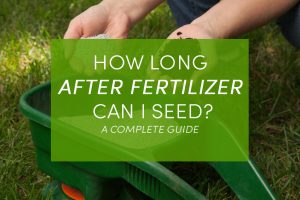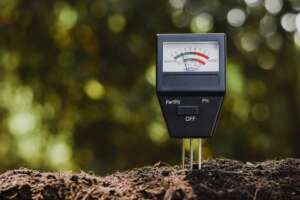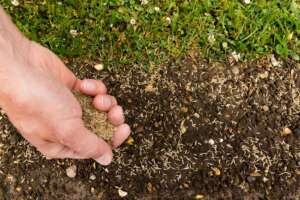Table of Contents
 Seeds demand favorable environmental conditions so that they can grow, and germinate to their fullest. To ensure the proper germination, we first need to prepare our land for it. If you are about to set your lawn, you must be wishing for the best results.Â
Seeds demand favorable environmental conditions so that they can grow, and germinate to their fullest. To ensure the proper germination, we first need to prepare our land for it. If you are about to set your lawn, you must be wishing for the best results.Â
Before starting, many questions might pop up in your mind. What fertilizers should I try? Should I seed first or prepare the land first? What are the best environmental conditions ? How long should I wait after fertilizing my land? WELL! This article will answer all your queries. Follow the instructions regarding the fertilization process and seeding. You will be able to jog on a lush green lawn.Â
Continue reading and get to know about best practices to grow a lush green garden or lawn.
Best practices; to seed after fertilizers.
Before pouring any fertilizers into your soil, it is important to know the type of grass you want to grow. Moreover, you also need to navigate the best times in which particular grass grows best, and they decide on fertilizing your soil.Â
If your lawn is new, you can add fertilizers to the soil, and after that added seed after one hour or immediately. Fertilizers will enhance the growth of baby seeds, and the germination process will enhance. Make sure your fertilizers do not have any pesticides. You are adding fertilizers and seeds for the first time. Any harmful agent in the fertilizers can hinder the growth of baby grass seeds.Â
Step 1. Check pH of the soil

Before adding fertilizers, you need to understand the nature of your soil. Maintain a beneficial pH in your soil by adding fertilizers. You can go to the nearest laboratory with a sample of your soil. Otherwise, consider buying a soil pH test kit .
An ideal pH for lush green healthy grass ranges around 6.3 to 7. If the pH of your grass is between 6.2 to 7, then the soil is good to go for fertilizers. In other cases, you might need to consult a gardener to get the best results from first-time seeding.Â
Step 2. Prepare the soil for fertilizers
If you are growing your lawn for the first time, fertilizers will enhance the capability of your lawn. You need to work under the right conditions. The fertilizers should prepare the space enough. After fertilizers, when you see the roots of the grass should be more firm and strong in the soil before weeds try to invade the area.Â
- Start the process by tilling the soil.
- You can use a plow, hand tiller, Alamy, rake, or whatever is available.
- If the space is small, you can use hand tillers.
- In the case of large spaces, you can use a tractor with a tilling attachment.
- After tilling, you can add fertilizers to the soil.
- Follow the instruction for the number of fertilizers to the prescribed area of soil.
Tilling will make the soil soft, and it will better absorb water and nutrients from fertilizers. The soil will be richer with nutrients, and more grass will come out with great texture.
You May Also Like: How to Store Potatoes from the Garden: Harvesting and Storage
Step 3. Add seeds to the fertilized soil
Now comes the question that after how much time of fertilizing, can I seed? You can do so on the same day. Equally spread the fertilizer. Wait for an hour or two and start spreading the seeds.Â
Before seeding, makes sure that fertilizer does not contain any herbicides or pesticide-killing agents. This step will hinder the baby seed growth. Moreover, seeds will not germinate due to these pesticides in the fertilizers. If you can manage a purely organic fertilizer, that would be great.Â
Your seeds should:
- Deeply incorporated in the soil.
- It should have a coating that can fight against harmful agents.Â
- Should not be very close to the surface of the soil.Â
Step 4. Watering the seeds.
Maintain a balance to water the new seeds. The nutrients from fertilizer may float in the water if you add an excessive amount of water to the seeds. This step will not ensure the best germination and growth of the seeds. Moreover, the fertilized soil straightens the root system. In the case of plenty of water, the root of the seed may weaken at the weekend, and ultimately weeds can take place between the grass.Â
A minimal amount of water can also reduce germination if the seed does not absorb the required amount of water for germination. Maintain a balance by looking at the soil. Your purpose should be to saturate the surface of the soil and not to float water all around the grass surface.Â
When is the best time to seed?

The ideal time is a mediator time to grow the seed at its full capacity. If you seed in extreme summer, a baby seed cannot bear the warmth and rot ultimately. However, in extreme winters, the soil may fail to provide the required warmth to the seed, and seed germination would stop.Â
Plant seeds in early fall or spring. The weather is bad these days. The soil is warm enough to process germination. Moreover, the sunlight will also be bearable to the soil, seed, and new grass.Â
You May Also Like:Â Growing Potatoes Indoors: Step by Step Guide
Conclusion
Healthy and lush green grass comes out when you seed under a favorable environment. The moderate season such as spring and early fall are good to seed the new lawn. However, in winters and summers, seeding does not provide a suitable environment to sprout and germinate.
You can fertilize the soil after tilling. Then add seeds the same day. Make sure you equally distribute the fertilizers in the whole land. A large number of fertilizers in one area can lead to dead patches of soil due to excessive nitrogen. Grow your seeds at the right time and enjoy green and fresh grass in your garden. Â
